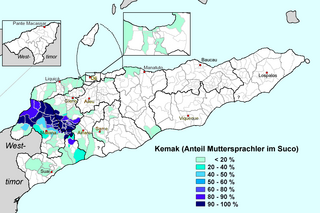Related Research Articles
Masaba (Lumasaaba), sometimes known as Gisu (Lugisu) after one of its dialects, is a Bantu language spoken by more than two million people in East Africa. The Gisu dialect in eastern Uganda is mutually intelligible with Bukusu, spoken by ethnic Luhya in western Kenya. Masaba is the local name of Mount Elgon and the name of the son of the ancestor of the Gisu tribe. Like other Bantu languages, Lumasaba nouns are divided into several sets of noun classes. These are similar to the genders in Germanic and Romance languages, except that instead of the usual two or three, there are around eighteen different noun classes. The language has a quite complex verb morphology.
Northeast Malakula, or Uripiv-Wala-Rano-Atchin, is a dialect chain spoken on the islands of Uripiv, Wala, Rano, and Atchin and on the mainland opposite to these islands. Uripiv-Wala-Rano-Atchin is spoken today by about 9,000 people. Literacy rate of its speakers in their own language is 10–30%.

Bontoc (Bontok) is the native language of the indigenous Bontoc people of the Mountain Province, in the northern part of the Philippines.

Kemak is a language spoken in East Timor and in the border region of Indonesian West Timor. An alternate name is Ema. It is most closely related to Tocodede and Mambai. It has the status of one of the national languages in the East Timor constitution, besides the official languages of Portuguese and Tetum. The number of speakers has fallen in recent years.
Wetarese is an Austronesian language of Wetar, an island in the south Maluku, Indonesia, and of the nearby island Liran.

Maʼya is an Austronesian language of the Raja Ampat islands in Southwest Papua, Indonesia. It is part of the South Halmahera–West New Guinea (SHWNG) subgroup and is spoken by about 6,000 people in coastal villages on the islands Misool, Salawati, and Waigeo, on the boundary between Austronesian and Papuan languages.
Central Asmat is a Papuan language of West New Guinea, spoken by the Asmat people.
Kovai is a Papuan language spoken on Umboi Island, halfway between mainland Papua New Guinea and the island of New Britain, and mostly within the caldera of that volcanic island.
Karenni or Red Karen, known in Burmese as Kayah, is a Karen dialect continuum spoken by over half a million Kayah people in Burma.
Tenetehára is a Tupi–Guarani language spoken in the state of Maranhão in Brazil. Sociolinguistically, it is two languages, each spoken by the Guajajara and the Tembé people, though these are mutually intelligible. Tembé was spoken by less than a quarter of its ethnic population of 820 in 2000; Guajajara, on the other hand, is more robust, being spoken by two-thirds of its 20,000 people.
Kawahíva is a Tupi–Guarani dialect cluster of Brazil. The major variety is Tenharim.
Yamdena is an Austronesian language of Yamdena and surrounding islands in the Maluku Islands in Indonesia. In 1991 there were an estimated 25,000 speakers of the language. Current BPS data has the present number of speakers at 69,000.
Orokaiva is a Papuan language spoken in the "tail" of Papua New Guinea.
Agusan is a Manobo language of northeastern Mindanao in the Philippines.
Choni (Jonê) and Thewo are dialects of a Tibetic language spoken in western China in the vicinity of Jonê County.
Fordata is an Austronesian language spoken in the Tanimbar Islands of the Moluccas. It is closely related to Kei, and more distantly to Yamdena, both also spoken in the Tanimbar Islands.
Taliabo (Taliabu) is a Malayo-Polynesian language spoken on the island of the same name in the Moluccas of Indonesia.
Wakasihu, or Larike-Wakasihu after the two still-vigorous dialects, is an Austronesian language of Ambon Island in the Maluku Islands.
Luang, also known as Literi Lagona, is an Austronesian language spoken in the Leti Islands and the Babar Islands in Maluku, Indonesia. It is closely related to the neighboring Leti language, with 89% shared basic vocabulary.
Kola is one of the Aru languages, spoken in the northernmost part of the Aru Islands, mainly on Kola Island and in the northern and western part of Wokam Island.
References
- ↑ East Tarangan at Ethnologue (18th ed., 2015) (subscription required)
West Tarangan at Ethnologue (18th ed., 2015) (subscription required) - ↑ Hughes, Jock (1987). "The languages of Kei, Tanimbar and Aru: Lexicostatistic classification" (PDF). In Soenjono Dardjowidjojo (ed.). Miscellaneous studies of Indonesian and other languages in Indonesia, part 9. NUSA 27. Jakarta: Universitas Katolik Indonesia Atma Jaya. pp. 71–111.
- 1 2 3 4 5 6 7 8 Nivens, Richard (1992). "A Lexical Phonology of West Tarangan". Phonological Studies in Four Languages of Maluku. Summer Institute of Linguistics and the University of Texas at Arlington.